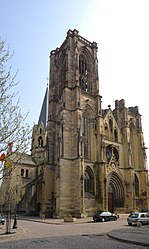
Rouffach
Rouffach | |
|---|---|
 The church in Rouffach | |
| Coordinates: 47°57′30″N 7°17′54″E / 47.9583°N 7.2983°E | |
| Country | France |
| Region | Grand Est |
| Department | Haut-Rhin |
| Arrondissement | Thann-Guebwiller |
| Canton | Wintzenheim |
| Intercommunality | Pays de Rouffach, Vignobles et Châteaux |
| Government | |
| • Mayor (2020–2026) | Jean-Pierre Toucas[1] |
Area 1 | 40.05 km2 (15.46 sq mi) |
| Population (2021)[2] | 4,186 |
| • Density | 100/km2 (270/sq mi) |
| Time zone | UTC+01:00 (CET) |
| • Summer (DST) | UTC+02:00 (CEST) |
| INSEE/Postal code | 68287 /68250 |
| Elevation | 195–980 m (640–3,215 ft) (avg. 210 m or 690 ft) |
| 1 French Land Register data, which excludes lakes, ponds, glaciers > 1 km2 (0.386 sq mi or 247 acres) and river estuaries. | |
Rouffach (French pronunciation: [ʁufak] ⓘ; German and Alsatian: Rufach) is a commune in the Haut-Rhin department in Grand Est in north-eastern France.

Rouffach lies along the Alsatian wine route (Route des Vins d'Alsace). Its vineyards produce one of the finest Alsatian wines: the Grand Cru Vorbourg.

Geography
Rouffach is situated on the Lauch River, 15 km (9.3 mi) south of Colmar and 28 km (17 mi) north of Mulhouse, on the vineyards of the eastern foothills of the Vosges Mountains. The most important transportation routes between the towns are the N83 (Lyon–Strasbourg) and the railway line Strasbourg-Mulhouse-Basel.

Climate
Rouffach has an oceanic climate (Köppen climate classification Cfb). The average annual temperature in Rouffach is 11.2 °C (52.2 °F). The average annual rainfall is 629.0 mm (24.76 in) with May as the wettest month. The temperatures are highest on average in July, at around 20.3 °C (68.5 °F), and lowest in January, at around 1.9 °C (35.4 °F). The highest temperature ever recorded in Rouffach was 39.3 °C (102.7 °F) on 13 August 2003; the coldest temperature ever recorded was −17.5 °C (0.5 °F) on 13 January 1987.

| Climate data for Rouffach (1981–2010 averages, extremes 1986−present) | |||||||||||||
|---|---|---|---|---|---|---|---|---|---|---|---|---|---|
| Month | Jan | Feb | Mar | Apr | May | Jun | Jul | Aug | Sep | Oct | Nov | Dec | Year |
| Record high °C (°F) | 18.8 (65.8) |
21.5 (70.7) |
26.2 (79.2) |
29.5 (85.1) |
34.0 (93.2) |
37.7 (99.9) |
38.0 (100.4) |
39.3 (102.7) |
33.5 (92.3) |
29.1 (84.4) |
23.1 (73.6) |
17.2 (63.0) |
39.3 (102.7) |
| Mean daily maximum °C (°F) | 4.6 (40.3) |
6.9 (44.4) |
11.2 (52.2) |
15.8 (60.4) |
20.1 (68.2) |
23.5 (74.3) |
25.6 (78.1) |
25.3 (77.5) |
20.7 (69.3) |
15.4 (59.7) |
9.1 (48.4) |
5.2 (41.4) |
15.3 (59.5) |
| Daily mean °C (°F) | 1.9 (35.4) |
3.5 (38.3) |
7.1 (44.8) |
11.0 (51.8) |
15.2 (59.4) |
18.4 (65.1) |
20.3 (68.5) |
19.9 (67.8) |
15.9 (60.6) |
11.4 (52.5) |
6.2 (43.2) |
2.7 (36.9) |
11.2 (52.2) |
| Mean daily minimum °C (°F) | −0.8 (30.6) |
0.1 (32.2) |
3.0 (37.4) |
6.2 (43.2) |
10.3 (50.5) |
13.3 (55.9) |
15.0 (59.0) |
14.6 (58.3) |
11.0 (51.8) |
7.5 (45.5) |
3.2 (37.8) |
0.1 (32.2) |
7.0 (44.6) |
| Record low °C (°F) | −17.5 (0.5) |
−14.7 (5.5) |
−12.5 (9.5) |
−3.5 (25.7) |
0.2 (32.4) |
4.2 (39.6) |
7.4 (45.3) |
6.0 (42.8) |
2.0 (35.6) |
−4.4 (24.1) |
−10.2 (13.6) |
−17.0 (1.4) |
−17.5 (0.5) |
| Average precipitation mm (inches) | 35.6 (1.40) |
30.5 (1.20) |
37.6 (1.48) |
40.8 (1.61) |
76.0 (2.99) |
63.2 (2.49) |
67.8 (2.67) |
69.8 (2.75) |
55.7 (2.19) |
62.4 (2.46) |
42.6 (1.68) |
47.0 (1.85) |
629.0 (24.76) |
| Average precipitation days (≥ 1.0 mm) | 6.9 | 7.6 | 7.7 | 8.5 | 11.3 | 9.8 | 9.7 | 10.2 | 7.7 | 9.7 | 8.4 | 8.7 | 105.9 |
| Source: Météo France[3] | |||||||||||||
Population
| Year | Pop. | ±% p.a. |
|---|---|---|
| 1968 | 5,053 | — |
| 1975 | 4,768 | −0.83% |
| 1982 | 4,615 | −0.46% |
| 1990 | 4,303 | −0.87% |
| 1999 | 4,187 | −0.30% |
| 2007 | 4,664 | +1.36% |
| 2012 | 4,561 | −0.45% |
| 2017 | 4,518 | −0.19% |
| Source: INSEE[4] | ||
Etymology
in pago qui vocatur Rubiaco (charter, 662), Rubiacum 12th century, Rufiacum 13th century. In records of the diocese of Strasbourg it is called Upper Mundat.

The name derives from the Gallo-Roman male's name Rubbius or Rubius ending with Celtic suffix -āko > -acum (cf. Welsh -og).

Similar place-names in France : Royat (Rubiacum 1147), Robiac (Robiaco 1119).

History

In the 5th century, the walled village (oppidum) beneath the stronghold of Isenburg was a residence of the Merovingian kings. According to pious legend[5] recorded in the chronicle of Ebersmunster, the son of King Dagobert II gave the city to Arbogast, bishop of Strasbourg, in the 7th century, after the bishop had re-awakened his son Sigebert from death in a hunting incident.[6] More certainly the fief was one of the most ancient belonging to Strasbourg.[7] It finally became the main town of an episocopal fief, which also included Eguisheim. The city quickly developed and a wall was built around it.

The golden age ended abruptly with the Thirty Years' War, when the town was devastated by the Swedes. Archduke Leopold Wilhelm of Austria held court in the city when he was in Alsace.[8] At the end of the war, when Alsace was conquered by France, the fief was abolished. The city again achieved prosperity, chiefly due to wine growing and the production of kirsch from the cherry orchards connected with the chateau, and because it was spared during the following wars.

During the time of Nazi annexation, a Nationalpolitische Erziehungsanstalt (National Political Institute of Education, NEPA, popularly known as Napola) was housed in a former sanatorium of the city (as of October 1940).


Sightseeing



Rouffach is a station on the Romanesque Route of Alsace (Route Romane d'Alsace).

- The Notre-Dame de l’Assomption Church of yellow sandstone was built in the Romanesque and Gothic styles. The transept is from the second half of the 11th century, the Gothic nave is from the 12th and 13th centuries, with Romanesque side portals. Construction on the building continued until 1508; the double steeple facade was never completed. The northern steeple is 56 m high, the southern steeple is only 42 m high. The tip of the crossing steeple reaches a height of 68 m. The building suffered severe damage during the French Revolution and appears relatively plain today. The voluminous structure of the church and the existence of several medieval styles of construction are all the more apparent to the observer, though. The rose window in the facade (14th century) is one of the most ambitiously designed in Alsace.
- The church (monastery) of the Franciscans was built at the end of the 15th century.
- Numerous buildings from the late Middle Ages and the Renaissance (old city hall, old granary) still give the city a medieval character.
- The Witch Tower, built in the 13th to the 15th centuries, served as a prison.
- The castle of Isenbourg, residence of King Dagobert II and his son Sigbert, and later the Strasbourg bishop also, no longer remains. Today, a luxury hotel is housed in a reconstruction from the 19th century.
- The Établissement public local d’enseignement agricole de Rouffach is a secondary school for technology, agriculture and wine growing.
Partner towns
Since 1964, Rouffach has been a partner of the German city of Bönnigheim in Baden-Württemberg.

Notable people
Born in Rouffach:

- Konrad Pelikan, 1478–1556, reformer and theologian
- Valentin Boltz, 1515–1560, theologian and author
- Conrad Lycosthenes (1518–1561), Humanist and encyclopedist
- François Joseph Lefebvre (1755–1820), French Revolutionary general and Marshal of France
Resident in Rouffach:

- Sebastian Münster, Humanist, was a student of Konrad Pelikan in Rouffach from 1509 to 1511
See also
References
- ^ "Répertoire national des élus: les maires". data.gouv.fr, Plateforme ouverte des données publiques françaises (in French). 2 December 2020.
- ^ "Populations légales 2021" (in French). The National Institute of Statistics and Economic Studies. 28 December 2023.
- ^ "Climate of Rouffach 1981-2010" (PDF) (in French). Météo-France. Retrieved June 14, 2022.
- ^ Population en historique depuis 1968, INSEE
- ^ "Un doute est permis sur la légende" (Grad, 1888.)
- ^ Noted in Charles Grad, "A travers l'Alsace et le Lorraine", Le Tour du monde: nouveau journal des voyages, 55 1888:285.
- ^ Grad, 1888.
- ^ Helfferich, Tryntje, The Thirty Years War: A Documentary History (Cambridge, 2009), p. 290.
External links
- The city in pictures (in French)
See what we do next...
OR
By submitting your email or phone number, you're giving mschf permission to send you email and/or recurring marketing texts. Data rates may apply. Text stop to cancel, help for help.
Success: You're subscribed now !




